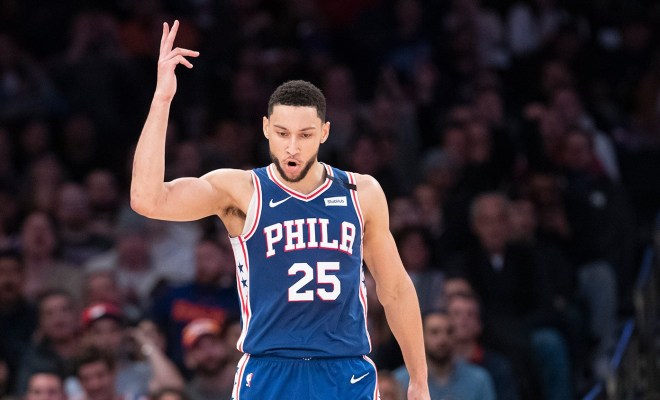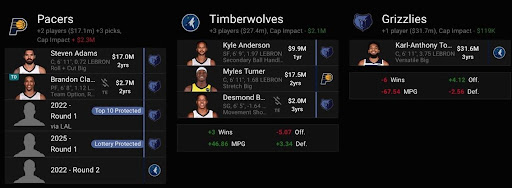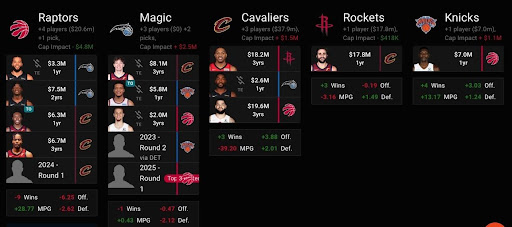-
 February 3, 2022, 7:58 pm
February 3, 2022, 7:58 pmLast Updated on February 3, 2022 7:58 pm by Mike Passador | Published: February 3, 2022
I am the Steinbrenner. With HoopBall’s recent rebranding into SportsEthos, I felt that using baseball terminology would be appropriate. But obviously, if you’re reading this, you’re here for the basketball content, so let me fill you in. George Steinbrenner was the New York Yankees owner from 1973 until his passing in 2010. Within that time, the Yankees won seven World Series and 11 AL Pennants. Writing this article reminds me of the Mister Softee episode of Curb Your Enthusiasm, where Larry David’s softball coach would scream “I am the Steinbrenner” because he was the one who ran the softball team. Well, that’s how my annual mock trade deadline makes me feel. I don’t have any children yet, but I consider the mock trade deadline as my first-born child.
I built it from the ground up, starting from playing with trade machines in early February and turning it into what you are about to read. For those of you who are unfamiliar, this is my first year at SportsEthos where I am the Front Office Analyst and the host of the Bird Rights Podcast, an NBA Front Office podcast that talks about everything front office and salary cap related. I am also the host of an independent podcast called The NBAgell, an all things NBA podcast.
In real life, this NBA season is on pace for the highest luxury tax distribution in history, so I anticipate a lot of teams doing everything possible to duck the tax this trade deadline. For example, teams like Boston, Philadelphia, and Portland are a hair over the luxury tax threshold and I expect at least Boston and Portland to get under the tax threshold. Other teams like Atlanta, Chicago, Denver, Miami, and Minnesota are right under it. While these teams are making moves, they must keep in mind the tax ramifications of said moves.
Every year I do this mock trade deadline and a mock offseason. Usually, it consists of me playing on the trade machine in my head, crunching numbers, and doing what trades make the most sense to me. This year, with the opportunity and platform that SportsEthos has given me, I decided to expand it. I have myself and 14 other great basketball minds helping me out.
Here are the basics: each person represents and negotiates as two teams. For example, I was the Houston Rockets and Memphis Grizzlies. Negotiations started on January 3, 2022 and went all the way through the publishing of this article. This is actually just part one of a three-part article. In this exercise, teams were constrained to real life CBA rules, such as the salary cap and luxury tax. Each team had a team agenda I sent out to them to attempt to abide by, but of course, it went off the rails a bit.
However, we tried making this as realistic as possible, and without further ado, here is where we ended up:
THE TRADE I PREACHED THAT DIDN’T HAPPEN

This would be a home run for all three teams involved. For the Pistons, they would have gotten a young building block in Cam Reddish that is due a rookie extension this summer, as well as a cost-controlled 21-year-old for reasonable money. Both guys fit their timeline well. This trade was suggested prior to Reddish’s trade to the Knicks and it became apparent that Reddish was the odd man out regarding getting paid by Atlanta. With De’Andre Hunter due a rookie extension, as well as Trae Young, John Collins, Clint Capela, and Kevin Huerter already signing extensions, this Hawks team is going to get expensive quickly.
The Hawks could be in desperation mode, as they are currently a play-in team after reaching the conference finals just one year ago. Atlanta has the league’s 27th ranked defense, and Grant’s versatility could help tremendously. Meanwhile, the Lakers desperately need a player who can play off LeBron and Westbrook. Bogdanovic is an awesome secondary ball handler, as well as an off-ball shooter. He can facilitate a bit and shoots 38.6% from 3 for his career. He is an absolutely awesome fit for the Lakers, much better than Talen Horton-Tucker.
THE TRADE THAT ALMOST HAPPENED, BUT DIDN’T

Surprisingly, this trade made it to the five-yard line. And even more surprisingly, Memphis is the one who did not agree. Both the Pacers and Timberwolves quickly jumped on board for this trade. Let’s break this down. First off, I was the GM of the Grizzlies, so I can attest to rejecting this trade. While it is unrealistic that the Timberwolves part with Karl-Anthony Towns, it may be in the realm of possibility sometime in the future if Minnesota continues to struggle to win. But the unlikeliness of it all is not the reason I rejected it as Memphis.
Memphis has Steven Adams at center as Ja Morant’s pick-and-roll partner. Even without Morant, the Grizzlies’ record is 11-2. Basically, what I’m trying to say is that the Grizzlies have a good thing going. And fit matters. A LOT. Spacing in the NBA is always a good thing, a great thing actually. But having two of the best shooting big men of this generation in Karl-Anthony Towns and Jaren Jackson Jr. leaves very few options to play in the post. Would Towns elevate the Grizzlies to the next level? Probably. But is he so much of a game changer that it was worth giving up two 1st rounders, Kyle Anderson, Steven Adams, Desmond Bane, and Brandon Clarke? I don’t believe so.
For Minnesota, while they trade their franchise centerpiece and the best player they’ve had on their roster long term since Kevin Garnett, the downgrade from KAT to Myles Turner is slight. In fact, Turner may be even better for the Wolves due to his ability to protect the rim. And then getting Desmond Bane for the next two years after this year and then his restricted free agent rights? Sign me up! Kyle Anderson helps fill a void that Jarred Vanderbilt is finally starting to fill as the power forward for this team.
As for Indiana, Turner’s injury has complicated things. Pre-injury, the Pacers could have anticipated getting multiple first rounders for Myles Turner. Now, maybe they get a first plus a young player. Here, they would have gotten that in addition to a young big on a rookie deal in Brandon Clarke. Despite the Grizzlies being one of the deepest teams in the league that could’ve consolidated some of their pieces, Memphis felt this wasn’t the deal for them. Ultimately, Memphis preferred the assets and Steven Adams.
THE FIRST DEAL THAT WENT DOWN

The trade that kicked us off sent rumblings to the rest of the league. I was so proud of myself to watch my first-born start with a 5-teamer.
Raptors receive: Isaac Okoro, Collin Sexton, Mo Bamba, Michael Carter-Williams, $3.3 million cash from Orlando, and 2024 unprotected Cleveland 1st
Magic receive: Kevin Knox, Malachi Flynn, Cedi Osman, and the Raptors 2025 1st (top 3 protected), 2023 DET 2nd (from Knicks)
Cavs receive: Fred VanVleet, E’Twaun Moore, and Eric Gordon
Rockets receive: Ricky Rubio
Knicks receive: Chris Boucher
Remember when I said all 15 of us were taking this as realistically as possible? Yeah, so do I. I told every GM in the beginning of this exercise that I have final discretion on all trades, even if all the owners approve. This is one I considered vetoing just because I don’t see the Raptors trading VanVleet. Every other part of the offer, though, made sense. Not only that, but I was so proud of a five-teamer coming together, I couldn’t say no! Now, the CBA implemented the ‘touch rule,’ which requires every team in a multi-team trade to give something of value to each team involved. While that did not get accomplished here, multiple of these players could have been dealt separately in smaller trades, such as Eric Gordon for Rubio or Boucher for Knox and the pick. But that doesn’t look as fun on paper, so alas!
We see it every year. A team that is semi-competitive decides to blow it up. Last year, it was Orlando. The year before that, it was Memphis. This year, could it be Toronto? Let’s start with the Toronto aspect of this. They’re getting Mo Bamba and Collin Sexton, who both will get paid handsomely this summer in free agency. But Toronto gets their restricted rights, so provided they are willing to match, those guys are not going anywhere. Additionally, Isaac Okoro and a 2024 1st is nothing to scoff at. VanVleet’s value is at an all-time high, and this is a pretty huge return for him.
For Cleveland, they get to pair VanVleet with Darius Garland, and Eric Gordon helps them with their wing depth after parting ways with Osman and Okoro. Additionally, Cleveland will now get to avoid playing the cat and mouse game with Collin Sexton’s free agency. Cleveland is cashing in on the success they’ve had this season and really pushing their chips in with this trade.
Orlando has a juggernaut of young talent, and with Wendell Carter Jr. already signed long term, they flip Bamba to get a lightly protected 2025 Toronto 1st from a team who traded away their All-Star point guard, a likely high 2023 2nd, and they get to take a flier on Malachi Flynn (who they end up subsequently flipping to Minnesota).
For Houston, this trade was about getting off Eric Gordon’s money beyond this year. If I’m being honest, Eric Gordon’s trade value is higher than it has been in years, and I anticipate him fetching a first-round pick in the trade market. But Tilman Fertitta is the cheapest owner in sports, and it would not shock me if Houston prioritized getting off the money. Finally, the Knicks trade a high second-rounder and salary filler for Chris Boucher, who can shore up their center rotation and help them compete for a playoff berth for the second consecutive year.
TORONTO CONTINUES TO BLOW IT UP

Now, Keith, the host of SportsEthos’ Bulls coverage (representing Chicago), knew his buddy and co-host, Trey (representing OKC) could not resist trading one of the picks out of the treasure trove for Ayo Dosunmu. Has Dosunmu been good enough already to warrant that ’25 Sixers pick that could become pretty good pending Joel Embiid’s health and Ben Simmons’ inevitable exit? Is it crazy to say yes? However, OKC has 19 first-rounders in the next eight drafts, so they need to cash in some of those for players eventually, plus Dosunmu fits the timeline well.
Honestly, it would take a trade like this to go down for the Bulls to be willing to go into the luxury tax. But as things stand, they are currently the #2 seed in the East, so paying the tax to make them legitimate contenders is a small price to pay. Imagine a starting lineup of DeRozan, LaVine, Lonzo Ball, Vucevic, and Siakam, with the Bald Mamba coming off the bench. The Bulls, though, essentially give up all their young talent to push their chips in and bet on Siakam. Again, while it is unlikely that Toronto blows it up and moves Siakam, Chicago could trade Coby White, and maybe even Patrick Williams if the right deal comes along. White has really rehabilitated his trade value since Lonzo Ball went down. Many Bulls fans are talking about Jerami Grant, but anywhere Grant is traded to, he’s going to want a four-year, $112 million extension. If the Bulls, or any other trade partner, don’t think he’s worth that, then you’ll be trading for him for this year and next year. Siakam is at least locked up for two more years beyond this one.
Meanwhile, despite Collin Sexton and Mo Bamba both hitting restricted free agency, imagine a young Toronto core of Scottie Barnes, OG Anunoby, Collin Sexton, Patrick Williams, and Mo Bamba, in addition to Isaac Okoro, Gary Trent Jr., Coby White, etc. Worth rebuilding for? I think so. The reason I pushed this trade through is because Masai Ujuri isn’t afraid of big deals and if this offer ever came across his desk, he’d pounce.
BEN SIMMONS IS FINALLY ON THE MOVE

Sacramento is forever in the purgatory of debating whether to rebuild or compete. They have not made the playoffs in 15 years. But can you imagine Ben Simmons and De’Aaron Fox on the same team? Those are the two fastest players in the league coast-to-coast. The Kings also had a historically bad defense last year, albeit under Luke Walton. Simmons is the most versatile defender in the NBA and solves a lot of those problems for Sacramento. This trade puts Sacramento dangerously close to the tax threshold, though.
For the Sixers, they are currently .5 games out of the one seed despite Ben Simmons sitting out the season. With this trade, they get a 21-year-old young prospect they can develop or, in the alternative, flip with picks for that co-star they’re looking for. Haliburton can either be a primary ball-handler or the best secondary ball-handler in the league. When De’Aaron Fox was out due to health and safety protocols, Haliburton averaged 23.5 points and 11.3 assists. Not to mention, he just dropped a career high 38 points in front of Daryl Morey in South Philly. And Haliburton has size, which the Sixers’ backcourt lacks. Not only that, but he’s a pretty good shooter. And Hield is an elite shooter. Adding these two next to Joel Embiid and a squad that’s contending would be pretty frightening. Additionally, the Sixers would be betting on the Kings continuing their playoff drought and potentially get two picks that they can use or flip to land a bigger fish.
CLIPPERS GET THEIR PLAYMAKER

Wall actually generated more interest than I expected him to. Minnesota, Boston, and Clippers all had interest. We saw the Clippers trade Lou Williams and multiple seconds for Rajon Rondo at the deadline last year. Unfortunately for them, “Playoff Rondo” never materialized. That was the Clippers’ first attempt to add a primary playmaker, but the issue remains unresolved. Reggie Jackson is fine, and Eric Bledsoe is a shell of his old self. Meanwhile, John Wall has only played in 40 games since 2019, so we aren’t sure what he is at this point either. While he lacks the athleticism and speed his game used to be predicated on, court vision and basketball IQ don’t age. This trade was accomplished prior to the announcement that Paul George is potentially out for the season and the Clippers will be sellers at the deadline to reduce their luxury tax bill, but it still makes sense in theory.
With this year mostly a wash for the Clippers due to Paul George and Kawhi Leonard’s injuries, Wall may be the perfect point guard for this situation next year when the Clippers are back to full strength. Additionally, Steve Ballmer is the richest owner in sports, so the Clippers are the team that comes to mind when you consider who can eat John Wall’s contract and pay that huge luxury tax bill. Eric Bledsoe only has $4 million guaranteed next season, Ibaka is on an expiring and moving him opens up minutes for Isaiah Hartenstein, and I’ve been a huge advocate that Marcus Morris is extremely overpaid on the recent contract that he signed. And as I said earlier, the Rockets owner would love to save some dough on that Wall contract, so that’s what this trade is about for them.
A MOVE AROUND THE MARGINS
Thunder receives: Denver 2025 2nd and Rodney McGruder
Nuggets receive: Kenrich Williams
Kenny Hustle is a player. But at 27 years old already, he’s more of a player who can be a rotation piece for a contender, rather than a building block for a rebuilder. In this exercise, we executed the Bol Bol for Rodney McGruder swap, which ended up being reversed. In Denver’s team agenda, I asked them to acquire players with more than one year on their deal, as they’ll likely be more of a contender next year rather than this year’s injury-riddled season. This trade accomplishes exactly that. For OKC, they had to clear two roster spots to bring in Dosunmu and the rest of the guys in the Bulls trade. Why not add a second to the stockpile of picks you have?
Ultimately, this exercise did not start how I wanted it to. But the whole point of this exercise is to make sense of what we can anticipate at the trade deadline, and everything in this article was thought out with reason. While all these players are not going to get traded, I expect them to at least have their names on the market. Stay tuned this weekend for part two of this experiment!
